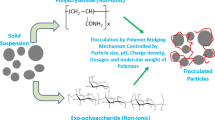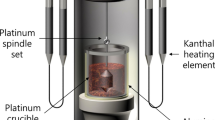Abstract
The relationship between viscosity/yield stress and flotation rate in different chalcopyrite and lizardite concentrations was investigated by zeta potential measurements, rheological tests, flotation experiments, and Derjguin-Landau-Verwey-Overbeek theoretical calculation. Results indicated that the concentration of minerals would affect the viscosity and yield stress of the slurry. That is, the viscosity/yield stress in the slurry rises accordingly when the concentration of minerals increases. The increase in viscosity/yield stress in slurry is also unfavorable to the enrichment of chalcopyrite but is conducive to the entrainment of lizardite in either single or binary system. Specifically, the flotation rate of chalcopyrite decreases while that of lizardite increases with the rise in viscosity/yield stress.
摘要
本文通过动电位检测、流变性测试、浮选试验和DLVO理论计算探究了不同浓度黄铜矿和利蛇 纹石条件下矿浆黏度及屈服应力与浮选速率间的关系。结果表明,矿物浓度能影响矿浆的黏度及屈服 应力值:当矿物浓度增加时,矿浆黏度及屈服应力也相应增大; 在单矿物或混合矿体系下,矿浆黏度 或屈服应力的增加不利于黄铜矿的富集,但有利于蛇纹石的夹带:随着矿浆黏度及屈服应力的增加, 黄铜矿的浮选速率降低而利蛇纹石的浮选速率增加。
Similar content being viewed by others
References
XU Peng-yun, WANG Qiang, LI Chuang, et al. Relationship between process mineralogical characterization and beneficiability of low-grade laterite nickel ore [J]. Journal of Central South University, 2021, 28(10): 3061–3073. DOI: https://doi.org/10.1007/s11771-021-4794-7.
LAN Zhuo-yue, LAI Zhen-ning, ZHENG Yong-xing, et al. Recovery of Zn, Pb, Fe and Si from a low-grade mining ore by sulfidation roasting-beneficiation-leaching processes [J]. Journal of Central South University, 2020, 27(1): 37–51. DOI: https://doi.org/10.1007/s11771-020-4276-3.
RAMIREZ A, GUTIERREZ L, VEGA-GARCIA D, et al. The depressing effect of kaolinite on molybdenite flotation in seawater [J]. Minerals, 2020, 10(6): 578. DOI: https://doi.org/10.3390/min10060578.
WANG Yan-hong, PENG Yong-jun, NICHOLSON T, et al. The role of cations in copper flotation in the presence of bentonite [J]. Minerals Engineering, 2016, 96–97: 108–112. DOI: https://doi.org/10.1016/j.mineng.2016.06.012.
GAO Ya-wen, ZHANG Guo-fan, WANG Meng-tao, et al. The critical role of pulp density on flotation separation of nickel-copper sulfide from fine serpentine [J]. Minerals, 2018, 8(8): 317. DOI: https://doi.org/10.3390/min8080317
ZHANG Guo-fan, GAO Ya-wen, CHEN Wei, et al. The role of water glass in the flotation separation of fine fluorite from fine quartz [J]. Minerals, 2017, 7(9): 157. DOI: https://doi.org/10.3390/min7090157.
ZHANG Ming, PENG Yong-jun. Effect of clay minerals on pulp rheology and the flotation of copper and gold minerals [J]. Minerals Engineering, 2015, 70: 8–13. DOI: https://doi.org/10.1016/j.mineng.2014.08.014.
FARROKHPAY S, NDLOVU B, BRADSHAW D. Behavior of talc and mica in copper ore flotation [J]. Applied Clay Science, 2018, 160: 270–275. DOI: https://doi.org/10.1016/j.clay.2018.02.011.
WANG Yan-hong, PENG Yong-jun, NICHOLSON T, et al. The different effects of bentonite and Kaolin on copper flotation [J]. Applied Clay Science, 2015, 114: 48–52. DOI: https://doi.org/10.1016/j.clay.2015.05.008.
CHEN Xu-meng, HADDE E, LIU Shi-qi, et al. The effect of amorphous silica on pulp rheology and copper flotation [J]. Minerals Engineering, 2017, 113: 41–46. DOI: https://doi.org/10.1016/j.mineng.2017.08.001.
FARROKHPAY S. The importance of rheology in mineral flotation: A review [J]. Minerals Engineering, 2012, 36–38: 272–278. DOI: https://doi.org/10.1016/j.mineng.2012.05.009.
MESA D, BRITO-PARADA P R. Scale-up in froth flotation: A state-of-the-art review [J]. Separation and Purification Technology, 2019, 210: 950–962. DOI: https://doi.org/10.1016/j.seppur.018.08.076.
RALSTON J, FORNASIERO D, GRANO S, et al. Reducing uncertainty in mineral flotation-flotation rate constant prediction for particles in an operating plant ore [J]. International Journal of Mineral Processing, 2007, 84(1–4): 89–98. DOI: https://doi.org/10.1016/j.minpro.2006.08.010
CHOI J, CHOI S Q, PARK K, et al. Flotation behaviour of malachite in mono- and di-valent salt solutions using sodium oleate as a collector [J]. International Journal of Mineral Processing, 2016, 146: 38–45. DOI: https://doi.org/10.1016/j.minpro.2015.11.011.
KIM G, PARK K, CHOI J, et al. Bioflotation of malachite using different growth phases of Rhodococcus opacus: Effect of bacterial shape on detachment by shear flow [J]. International Journal of Mineral Processing, 2015, 143: 98–104. DOI: https://doi.org/10.1016/j.minpro.2015.09.012.
FENG Bo, LU Yi-**, FENG Qi-ming, et al. Talcserpentine interactions and implications for talc depression [J]. Minerals Engineering, 2012, 32: 68–73. DOI: https://doi.org/10.1016/j.mineng.2012.03.004.
KIM G, CHOI J, SILVA R A, et al. Feasibility of bench-scale selective bioflotation of copper oxide minerals using Rhodococcus opacus [J]. Hydrometallurgy, 2017, 168: 94–102. DOI: https://doi.org/10.1016/j.hydromet.2016.06.029.
LU Ji-wei, YUAN Zhi-tao, LIU Jiong-tian, et al. Effects of magnetite on magnetic coating behavior in pentlandite and serpentine system [J]. Minerals Engineering, 2015, 72: 115–120. DOI: https://doi.org/10.1016/j.mineng.2014.12.038.
NDLOVU B, BECKER M, FORBES E, et al. The influence of phyllosilicate mineralogy on the rheology of mineral slurries [J]. Minerals Engineering, 2011, 24(12): 1314–1322. DOI: https://doi.org/10.1016/j.mineng.2011.05.008.
DENG Jiu-shuai, WEN Shu-ming, LIU Jian, et al. Adsorption and activation of copper ions on chalcopyrite surfaces: A new viewpoint of self-activation [J]. Transactions of Nonferrous Metals Society of China, 2014, 24(12): 3955–3963. DOI: https://doi.org/10.1016/S1003-6326(14)63556-1.
LUCKHAM P F, ROSSI S. The colloidal and rheological properties of bentonite suspensions [J]. Advances in Colloid and Interface Science, 1999, 82(1–3): 43–92. DOI: https://doi.org/10.1016/S0001-8686(99)00005-6.
SCHUBERT H. On the optimization of hydrodynamics in fine particle flotation [J]. Minerals Engineering, 2008, 21(12–14): 930–936. DOI: https://doi.org/10.1016/j.mineng.2008.02.012.
XU D, AMETOV I, GRANO S R. Detachment of coarse particles from oscillating bubbles—The effect of particle contact angle, shape and medium viscosity [J]. International Journal of Mineral Processing, 2011, 101(1–4): 50–57. DOI: https://doi.org/10.1016/j.minpro.2011.07.003.
PATRA P, BHAMBHANI T, VASUDEVAN M, et al. Transport of fibrous gangue mineral networks to froth by bubbles in flotation separation [J]. International Journal of Mineral Processing, 2012, 104–105: 45–48. DOI: https://doi.org/10.1016/j.minpro.2011.11.007.
LONG Tao, HUANG **ao-tao, XIAO Wei. The effect of surface charge on the separation of pyrite from serpentine by flotation [J]. Minerals, 2019, 9(10): 629. DOI: https://doi.org/10.3390/min9100629.
LIU Bao, HAO Liang-ying, LI Cai-xia. Study on the effect of serpentine on chalcopyrite flotation[J]. Non-Metallic Mines, 2016, 39(5): 19–22. DOI: https://doi.org/10.3969/j.issn.1000-8098.2016.05.007. (in Chinese)
BREMMELL K E, FORNASIERO D, RALSTON J. Pentlandite-lizardite interactions and implications for their separation by flotation [J]. Colloids and Surfaces A: Physicochemical and Engineering Aspects, 2005, 252(2, 3): 207–212. DOI: https://doi.org/10.1016/j.colsurfa.2004.10.100.
Author information
Authors and Affiliations
Contributions
SHI Qing provided the concept and instruction. HU Jia-cheng conducted the experimental test and wrote the draft of the manuscript.
Corresponding author
Additional information
Conflict of interest
SHI Qing and HU Jia-cheng declare that they have no conflict of interest.
Foundation item: Project(2018TP1002) supported by the Key Laboratory of Hunan Province for Clean and Efficient Utilization of Strategic Calcium-containing Mineral Resources, China; Project(2019zzts994) supported by the Central South University Graduate Research and Innovation Project, China
Rights and permissions
About this article
Cite this article
Hu, Jc., Shi, Q. Relationship between rheological behavior and flotation rate in slurry with different chalcopyrite and lizardite concentration. J. Cent. South Univ. 29, 1479–1487 (2022). https://doi.org/10.1007/s11771-022-4935-7
Received:
Accepted:
Published:
Issue Date:
DOI: https://doi.org/10.1007/s11771-022-4935-7




